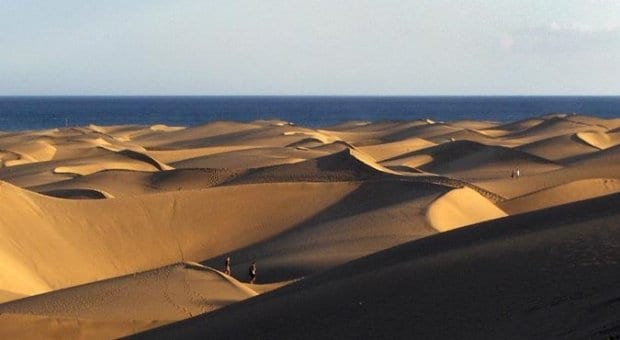Gran Canaria is the most gay-friendly destination in the Canary Islands, an archipelago situated just 200 kilometres off the northwest coast of Africa that for decades has been a favourite destination for Europeans in search of sunshine. In addition to fine beaches, the islands have a fascinating history to explore and plenty of relaxed revelry to enjoy, all with Spanish flair.
It’s generally accepted that the Gaunches from North Africa, descendants of Berbers, originally settled the islands. They lived mainly in caves and under rock spurs. Left pretty much alone until the 14th century, they were taken as slaves by Italians, Portuguese and Catalans, forcibly converted to Christianity, then quickly died out. In the mid-15th century, the Spanish arrived to rule the islands.
On the southwest coast of Gran Canaria, the communities of Playa del Inglés, Maspalomas and San Augustin have an abundance of shops, restaurants, bars and clubs, mostly built since the 1960s, alongside the famous Maspalomas Dunes. In contrast, the northern coast has a more traditional cultural ambiance, offering a change of scenery. Known as a “miniature continent” with different climates, the landscapes range from long beaches and white sand dunes to mountain terrain and lush green ravines with picturesque villages. A third of the island has been designated a UNESCO Biosphere Reserve.
Maspalomas has one of the best nude beaches in the world, complete with a gay section near the western end. There’s cruising in the nearby dunes, and shacks where you can buy cold drinks (they’re not cheap). The gay section is named for shack “Number 7” — just look for rainbow flags and the guys you saw at the clubs. You’ll see northerners on the sand earlier (craving every ray of sunshine), while Spanish locals tend to come out for a dip or for a beer at the chiringuito later, as the sun gets lower in the sky. Tip: Pack up before nightfall or risk being eaten alive by sand fleas. See GCGay for good beach information, in Spanish or (Google translation) English.
In many ways Maspalomas/ Playa del Inglés is the most laid-back of the four gay Spanish resorts. Unlike beach towns “on the peninsula,” winter doesn’t shut things down, and a cultural separation from mainland Spain makes for a slower pace of life. As Key West differs from Fort Lauderdale or Blackpool from Brighton, it’s just different — perhaps more Benidorm than Sitges — and certainly not Ibiza. Fashions are more casual, the boy-next-door has grown up but he won’t get turned away at the disco rope, and the partying usuallly ends when the sun comes up.
Weekdays are slow, building up to the weekends. Sundays involve a lazy brunch or Sunday roast and a timeout at the pool but not tea-party dancing. The scene is broadly international. British/Irish-accented English and German, along with Spanish, are the most often heard languages, with some French, Dutch, Italian and Scandinavian thrown in. But, at the end of the day, there are comfort-zone retreats that provide all things familiar — beers and food from home and the familiar acid wit of drag queen emcees. Also, with satellite TV, no one needs to miss her team’s next game or an episode of a favourite program.
It’s well worth visiting the capital of Gran Canaria. With about 400,000 inhabitants, Las Palmas is less touristy than the south shore communities, and it offers more historical sights and some lovely architecture. The city has some beaches, too, and local bars and restaurants serve traditional tapas, local seafood, beers and wines. Most Spanish businesses shut down during siesta hours, usually 2 to 5pm, so you’ll find better eating and shopping options during the early evening hours than in the mid-afternoon, when most places in Spain look like ghost towns.
Gran Canaria’s Pride event attracts more than 100,000 participants to Maspalomas for a whole week of entertainment and partying in May. Every business displays the colours of the rainbow. The streets are full of people in stunning costumes and suntanned men in skimpy swimsuits. The day ends in a huge outdoor dance party on Avenida de Tirajana.
The annual Mr Gay Gran Canaria events draw huge crowds, too, with festivities in and around the Yumbo Center. See the Pride link above for details.
Carnaval, celebrated in both Maspalomas and Las Palmas in the weeks before Lent, includes a drag queen night, shows, parade floats, street festivals with thousands in costume, and parties at all the clubs. In Maspalomas the action centres on Yumbo Center and along Avenida de Tirajana. Up north, Carnaval Las Palmas, which includes Gala de la Reina (Queen’s Show), takes place in Parque Santa Catalina and Plaza de la Feria, with Carnaval al Sol and the grand finale Entierro de la Sardina (the Sardine’s Funeral) seaside festivities at Playa de Canteras.
The infamous dunes provide opportunities for nudity and lots of all-male recreational fun. They’re best avoided during the heat of the day, but if you go, take water and perhaps tangerines or dates for a quick energy boost. A hat is helpful, too, especially for the guys with shaved heads — in straw or paper, Panama-style, they’re cheap and disposable and much cooler than a tight cap.
There are plenty of indoor cruising places. Besides two saunas; several sex clubs; naked nights in dark rooms with slings, et cetera; and porn-shop video lounges, there are dark rooms in the discos and in lots of other bars, especially the men’s clubs. “A basic service, like running water” is how local blogspot GCGay puts it. Check out squirt.org for more cruising tips.
For the most up-to-date travel information on gay Grand Canaria, see our City Guide, Listings Guide, Events Guide and Activities Guide.

 Why you can trust Xtra
Why you can trust Xtra